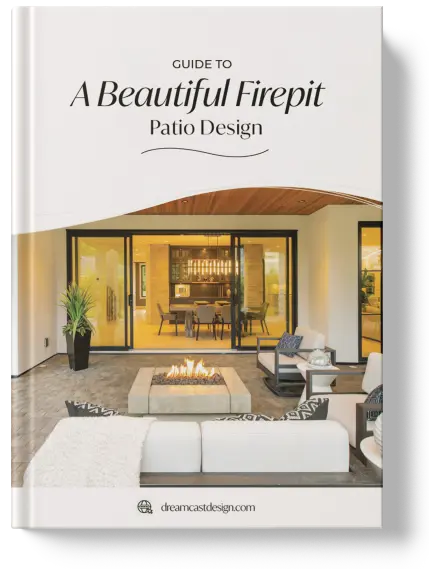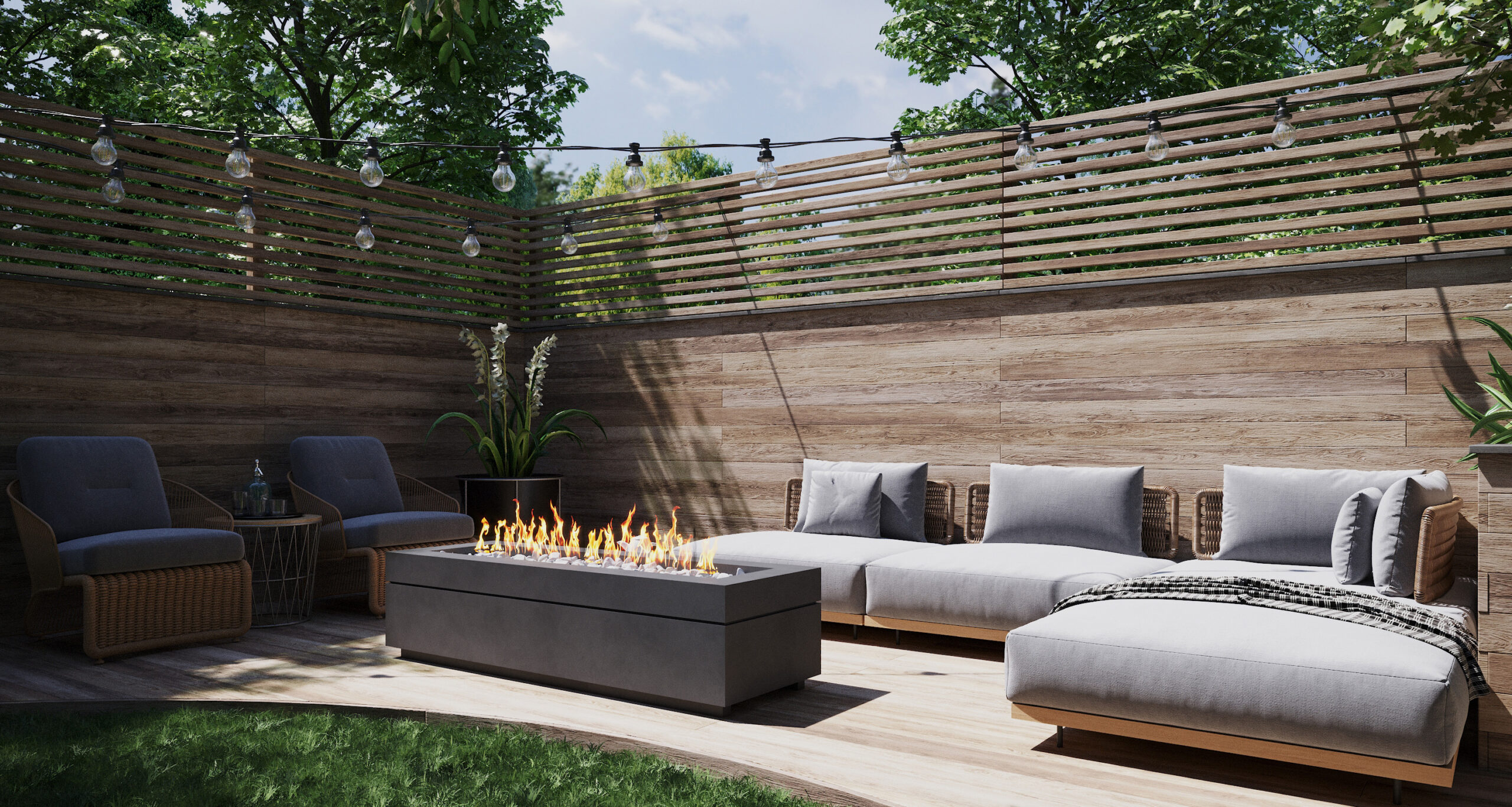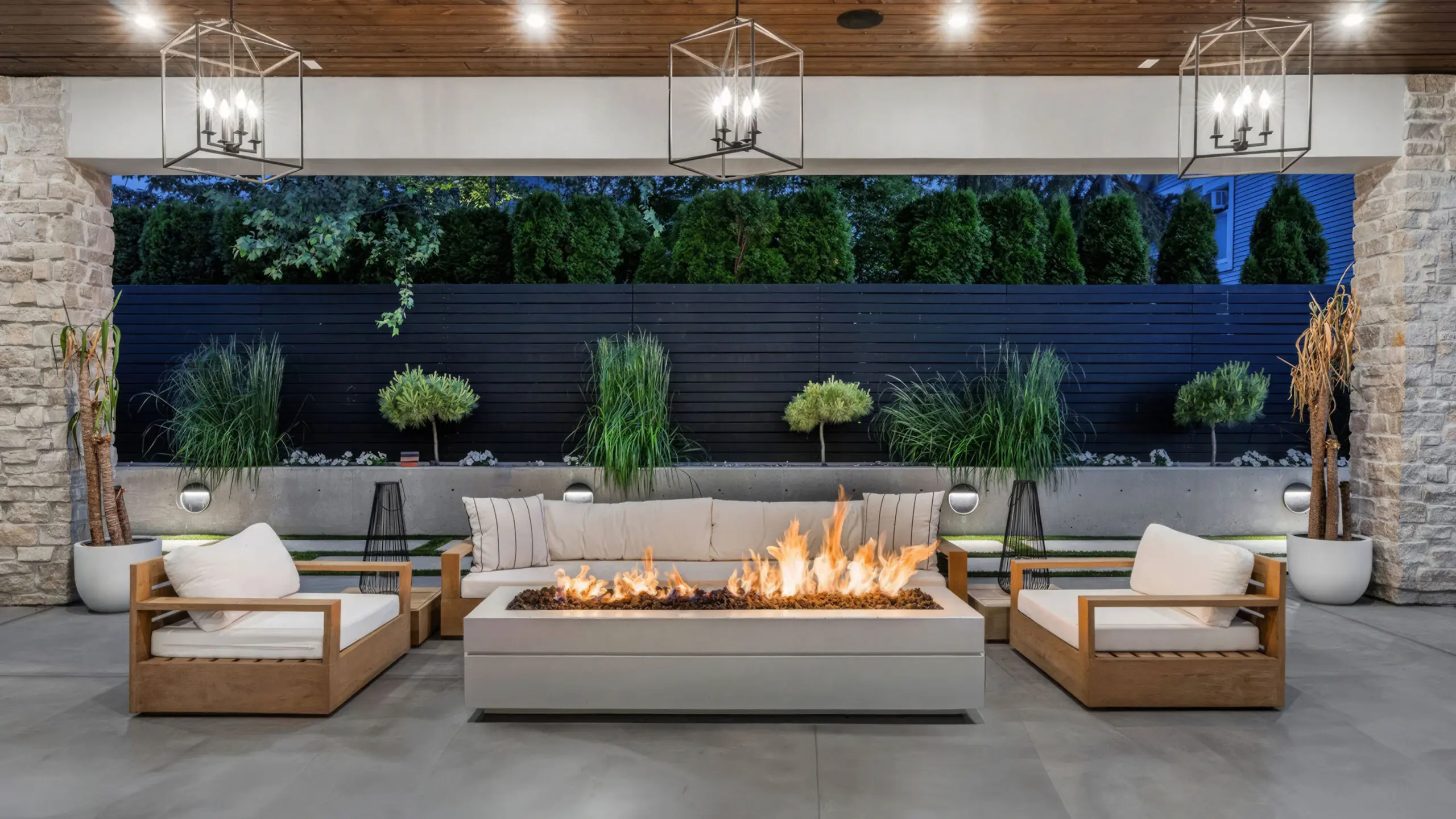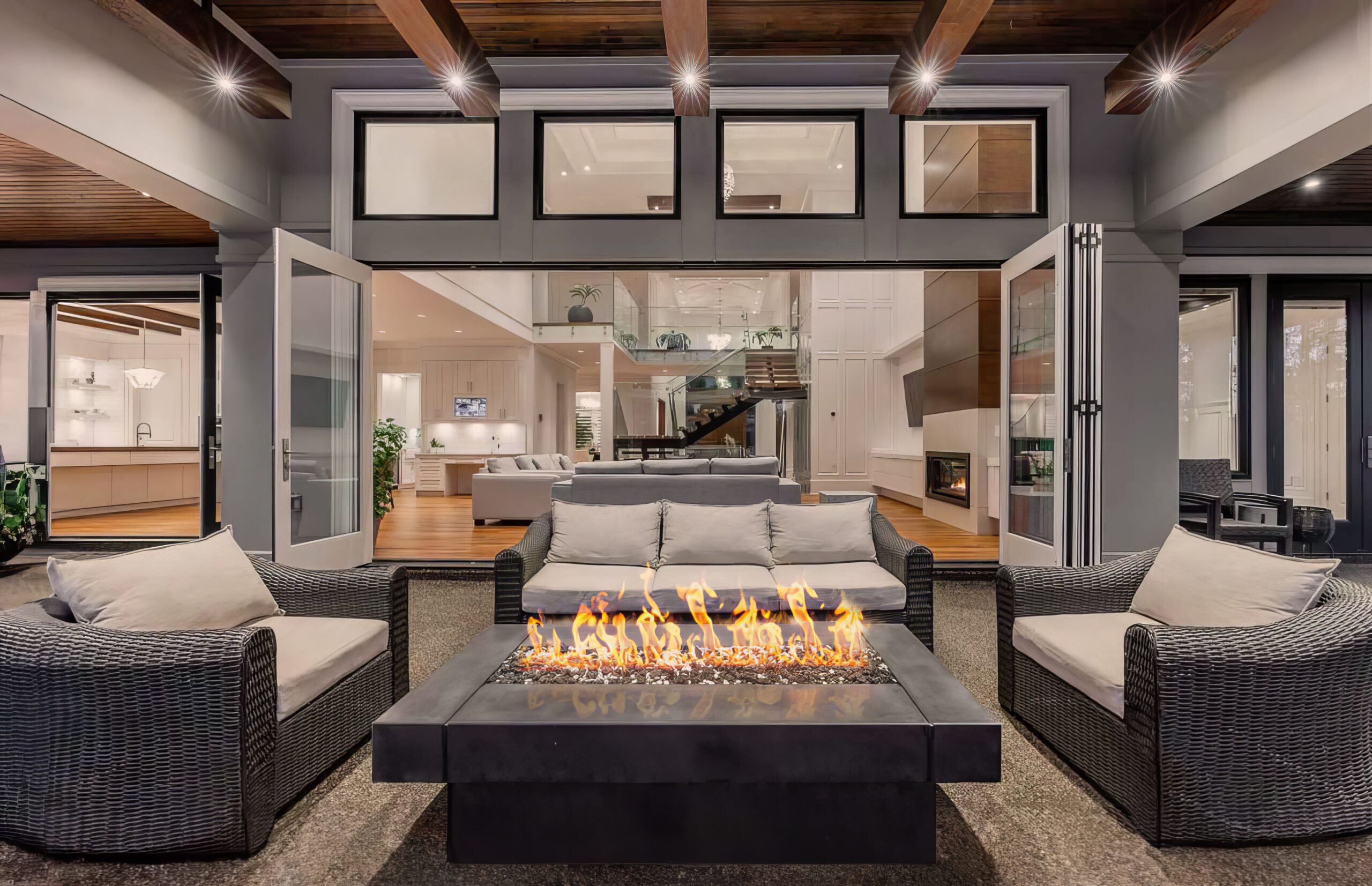Layout and Clearance Requirements for outdoor gas fire pits
Outdoor gas fire pits are a popular addition to patios, gardens, and outdoor spaces, offering warmth, ambiance, and a place for social gatherings. These fire features are fueled by natural gas or propane, making them a convenient and clean alternative to traditional wood-burning fire pits.
However, to ensure safety, efficiency, and optimal enjoyment, it’s essential to pay attention to proper layout and clearance when looking for landscaping ideas with fire pits.
In this blog post, we cover everything you need to know about fire pit layout and clearance requirements to transform your outdoor space into a cozy oasis of warmth and relaxation.

Understanding
Outdoor Gas Fire Pits
An outdoor gas fire pit is a modern fire feature that uses natural gas or propane as its fuel source, providing warmth and ambiance for outdoor spaces. Unlike traditional wood-burning fire pits, which require logs, kindling, and manual effort to start and maintain a fire, gas fire pits are much more convenient. They ignite at the push of a button or with an automatic ignition system and offer more control over flame height and heat output.
Why Layout and Clearance Matter
for gas fire pits
Safety Considerations
When choosing an outdoor gas fire pit, the layout and clearance are crucial for safety. One of the primary concerns is minimizing the risk of fire hazards, as an improperly placed fire pit can lead to flames or heat spreading to surrounding objects. It is essential to maintain a safe distance from flammable materials like trees, shrubs, wooden decks, furniture, and overhanging structures such as umbrellas or awnings. Many local fire codes and regulations dictate specific clearance requirements to ensure the safety of the area, and adhering to these guidelines helps prevent accidents. Ensuring sufficient space around the fire pit not only minimizes the risk of fire but also protects nearby individuals from exposure to excessive heat or potential flare-ups. We will go into detail further down the blog
Heat Distribution
Proper layout and clearance also enhance the efficiency of the gas fire pit. An optimal arrangement allows for better heat distribution, ensuring that warmth is evenly spread across the area, creating a more comfortable and enjoyable environment. A cluttered or poorly positioned fire pit accessory or burner can obstruct airflow, causing uneven heating or reduced flame performance. Clear space around the fire pit also prevents interference of the natural convection of heat, allowing it to radiate freely. This improves the overall efficiency of the fire pit, ensuring that it delivers consistent warmth without wasting fuel or leaving certain areas cold. Make sure to place your firepit accessories per manufacturer recommendations.
GET IN TOUCH
Still have questions about fire pit layout?
We are happy to help you!
Key Considerations for
Fire Pit Layout
Location
When considering where to put a fire pit, it’s essential to choose a spot that enhances both safety and functionality. The fire pit should ideally be placed on a stable, level surface, such as a patio, gravel area, or stone patio, which ensures that the fire pit remains steady and securely positioned. Additionally, consider the wind direction when choosing the location. A location sheltered from strong winds will prevent the flames from being blown erratically and reduce the risk of spreading heat to surrounding areas. If placed waterfront, a glass barrier will help shield from the wind.
Traffic flow is also important; avoid placing the fire pit in high-traffic areas where people may be at risk of getting too close to the flames. Lastly, think about visibility—placing the fire pit in a central, open space where it can be easily viewed from different angles enhances both its aesthetic and functional appeal, making it a focal point for gatherings.
Distance from Structures
The distance from nearby structures plays a crucial role in both safety and fire hazard prevention. Ensure there is adequate clearance between the fire pit and any flammable buildings such as your house, shed, or garage. Local fire safety codes typically recommend a minimum distance of 10-15 feet from structures to prevent accidental fires. DreamCast firepits must be 36″ away from combustible structures, and the overhead clearance depends on the ignition system. The proximity to fences, walls, or landscaping features should also be considered. These materials can be flammable, so it’s important to ensure that the fire pit is placed far enough away from them to prevent the flames or heat from causing damage. Additionally, the risk of fire spreading to trees, plants, or other outdoor features is minimized when a safe distance is maintained. By considering these factors, you reduce the likelihood of fire hazards and help ensure a safe and enjoyable fire pit experience.
Requirements
Surface selection is another critical consideration when laying out your fire pit. The fire pit should be placed on fire-resistant, non-combustible surfaces like concrete, gravel, or stone. These materials provide stability and protect the ground beneath from excessive heat if using wood burning firepits. Wood decks or grass areas should be avoided, as they are flammable and can catch fire from the heat of the flames. If you have to place the fire pit on a wooden deck, select a fire bowl rated for use on a deck. For example, DreamCast gas fire bowls can be placed on decks or rugs as they are certified for this use with no heat going downwards. The surface should also be level to ensure that the fire pit is stable, preventing tipping or imbalance. Ensuring that the surface is both stable and heat-resistant guarantees the safety of both the fire pit and the surrounding area, allowing for an enjoyable and secure experience.
Clearance Guidelines
for Safety
Recommended Clearance Distances
A general rule of thumb is to maintain a clearance of at least 10 feet from any structures such as your house, shed, or garage. This helps reduce the risk of fire spreading to the building due to intense heat or stray flames. Additionally, it’s recommended to maintain a clearance of at least 21 feet from trees, bushes, or any other vegetation. This distance prevents the heat from igniting leaves or branches and reduces the risk of a fire starting in nearby foliage. By following these clearance distances, you can ensure a safer fire pit experience while protecting your home and landscaping from potential fire damage. You should check the requirements of your specific firepit as it varies greatly between fuel and manufacturer.
Clearance from Furniture and Décor
When arranging your seating and decorative items around the fire pit, ensure that there is enough space—generally, at least 3 feet between the fire pit and any chairs, tables, or other furnishings for wood and 15″ for gas fueled firepits. This prevents people from being too close to the flames and reduces the risk of burns or discomfort from excessive heat. Additionally, it’s important to keep decorative items, like pillows, blankets, or rugs, at a safe distance, as these materials can easily catch fire if placed too near the flame. By maintaining adequate clearance, you not only ensure comfort but also significantly reduce the risk of heat damage to your furniture and décor.
Overhead clearance
Ensure there is ample space between the fire pit and any overhead structures such as tree branches, pergolas, umbrellas, or awnings. A minimum of 7 to 10 feet of clearance is typically recommended to allow heat and smoke to dissipate safely into the air. This also varies greatly with the heat output of the firepit. Wood burning and high BTU firepits typically can have nothing combustible overhead.
Placing the fire pit under an overhead structure without enough clearance can result in heat buildup, which could damage the structure or cause a fire. Tree branches, in particular, are highly flammable and can catch fire from intense heat or stray embers. By ensuring proper overhead clearance, you prevent these risks and create a safer environment for enjoying your outdoor fire pit.
Fire Pit Regulations
and Local Codes
It’s essential to be aware of local regulations and codes to ensure safety and compliance. Many areas require permits for fire pit installation, and some may have seasonal fire bans or restrictions depending on weather conditions, such as droughts or high winds, which increase fire risks. National safety standards, such as NFPA 58 (which governs the storage and handling of propane) and ANSI Z21.97 (which outlines standards for outdoor gas appliances), provide guidelines to ensure that fire pits are designed and installed safely. It’s also crucial to choose certified appliances and burners, as these meet safety criteria and help reduce the risk of malfunction. You can learn more about DreamCast’s safety certified firepits here. Before installation, always check with local authorities to confirm the specific codes and regulations in your area, as non-compliance could lead to fines or safety hazards. Understanding and adhering to these requirements ensures that your fire pit is both safe and legal for use in your community.

DISCOVER HOW TO CREATE YOUR PERFECT PATIO
Download this inspirational guide complete with tips & layouts to transform your patio today.

Inspiration
Looking for more ideas?
Check out our product gallery for more inspiration, or follow us on Instagram to keep up with the latest trends and promotions.
Author
Catherine Traschenko
Fire Products Design Specialist
As a partner at DreamCast, she has been immersed in the decorative concrete industry since 2007, specializing in fire pits & mantels. With a passion for interior design her expertise drives innovative design and exceptional craftsmanship.







